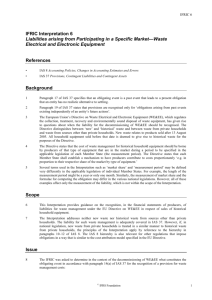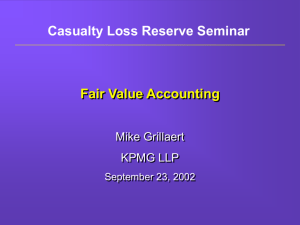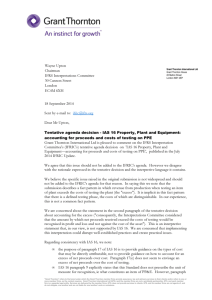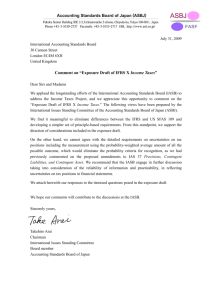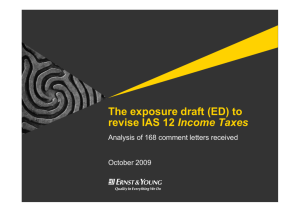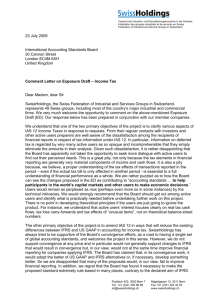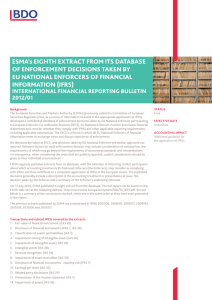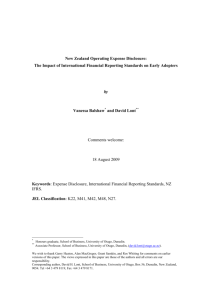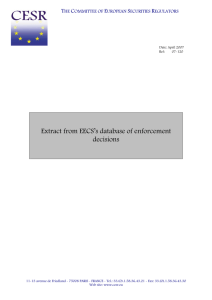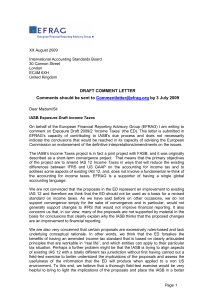Question 1
advertisement
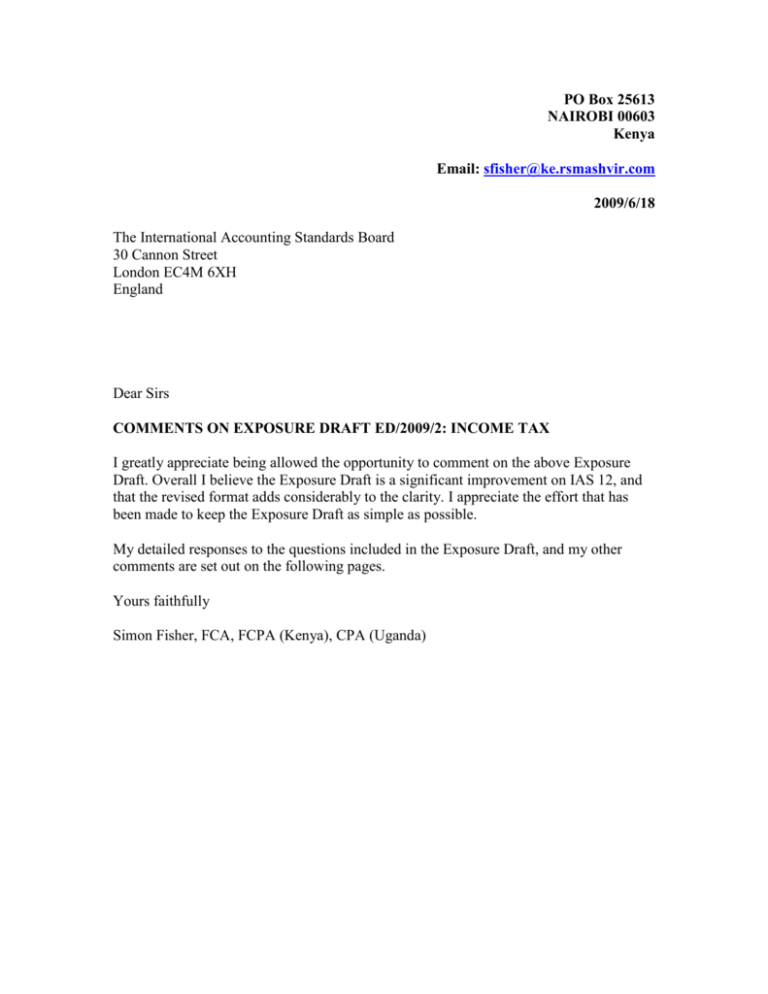
PO Box 25613 NAIROBI 00603 Kenya Email: sfisher@ke.rsmashvir.com 2009/6/18 The International Accounting Standards Board 30 Cannon Street London EC4M 6XH England Dear Sirs COMMENTS ON EXPOSURE DRAFT ED/2009/2: INCOME TAX I greatly appreciate being allowed the opportunity to comment on the above Exposure Draft. Overall I believe the Exposure Draft is a significant improvement on IAS 12, and that the revised format adds considerably to the clarity. I appreciate the effort that has been made to keep the Exposure Draft as simple as possible. My detailed responses to the questions included in the Exposure Draft, and my other comments are set out on the following pages. Yours faithfully Simon Fisher, FCA, FCPA (Kenya), CPA (Uganda) RESPONSES TO THE QUESTIONS INCLUDED IN THE EXPOSURE DRAFT Question 1 – Definitions of tax basis and temporary difference Yes. It seems to have little conceptual justification but will be a popular expedient, and will eliminate many temporary differences arising on initial recognition. Question 2 – Definitions of tax credit and investment tax credit Yes. Question 3 – Initial recognition exemption Yes. Basis of Conclusions is reasonable. Question 4 – Investments in subsidiaries, branches, associates and joint ventures Yes. Basis of Conclusions is reasonable. Question 5 – Valuation allowances Question 5A Yes. Question 5B Yes. Question 6 – Assessing the need for a valuation allowance Question 6A Yes Question 6B Yes. Question 7 – Uncertain tax positions No. The requirement to use a probability-weighted average is theoretical. In many cases there will be insufficient objective data/evidence to enable a probability-weighted average of all possible outcomes to be determined reliably. Further, there would need to be guidance on derecognising a liability if the liability was measured assuming that the tax authorities examines the amounts reported but then the tax authorities do not do so. At what point would an entity derecognise the liability? Income tax assets and liabilities should be determined as best estimates of the expenditure required to settle the obligation, consistent with IAS 37. Any uncertainty should be disclosed by way of key estimation assumptions or judgements in accordance with IAS 1. Contingent tax liabilities should be disclosed in accordance with IAS 37. Question 8 – Enacted or substantively enacted rate Yes. It is consistent with the concept of ‘best estimate of the expenditure required’. Question 9 – Sale rate or use rate No. It is illogical. The Basis for Conclusions does not put forward any justification for this other than convergence with US GAAP. If the tax basis is to be determined on the (expedient) assumption that the asset is to be sold, then this assumption should be applied throughout. There could be situations where for an initial period the deductions available on sale and on using the asset are the same, but in a later period they are different. It would not make sense to switch tax rates at the point the two tax bases start to diverge. Question 10 – Distributed or undistributed rate Yes. Consistent with the concept of best estimate of tax payable in respect of past transactions. However, in this instance, discounting of the liability arising on distribution should be allowed, since there might be a significant lapse of time before the monetary liability becomes payable. Question 11 – Deductions that do not form part of the tax basis Yes. Question 12 – Tax based on two or more systems Yes. Question 13 – Allocation of tax to components of comprehensive income and equity Question 13A No. The IAS 12 approach is more logical. The proposed approach could result in unnecessary and significant distortion of earnings per share (e.g. a change in tax rate used to measure deferred tax on revaluation surpluses). I understand US GAAP does not permit the revaluation of property, plant and equipment, so SFAS 109 would not have anticipated this situation. An alternative approach would be to remove the revaluation option allowed by IAS 16 as part of the convergence project. This would greatly simplify deferred tax computations. Question 13B Unable to comment (insufficient experience of applying SFAS 109). Question 13C Yes. It is more logical, and would avoid the unnecessary distortions to earnings per share referred to in 13A above. Question 13D Yes. Question 14 – Allocation of current and deferred taxes within a group that files a consolidated tax return Yes, although not applicable in my jurisdiction. Question 15 – Classification of deferred tax assets and liabilities Yes. It is simple and non-subjective, although not necessarily consistent with the “payable within 12 months” concept of IAS 1. Question 16 – Classification of interest and penalties Yes Question 17 - Disclosures a) Yes. b) I have no suggestions on useful incremental disclosures. Question 18 – Effective date and transition No. Entities should be allowed to make transfers between retained earnings and other components of equity, if practicable (consistent with paragraph 29A). The restatement could be significant and in our jurisdiction is likely to relate primarily to the revaluation of property, plant, and equipment. OTHER COMMENTS ON THE EXPOSURE DRAFT 1. Analysis by type of temporary difference Paragraph 46 requires disclosure for each “type” of temporary difference. Paragraph 18 explains that there are only two types of temporary difference. Is it intended that the disclosure required by paragraph 46 deals only with these two types? My suggestion would be that paragraph 46 requires disclosure for each line item in the statement of financial position for which temporary differences have been identified. 2. Tax reconciliation Paragraph 42(a) does not require any explanation of the reconciling items, and thus implies that the following disclosure would be acceptable: Accounting profit times applicable tax rate 1,000 Reconciling items 4,000 Tax expense 5,000 A common description of the reconciling items is “Expenses that are not deductible for tax purposes” (as used in the illustrative example No 22). This is: (a) ambiguous, as it is often understood as meaning ‘not deductible in the tax computation for the current period’ rather than ‘not deductible in any tax computation, now or in the future’; and (b) not very informative. My suggestion would be that paragraph 42(a) should require disclosure of sufficient explanation to enable a user of the financial statements to understand the nature of significant reconciling items. 3. Transfer of excess depreciation Paragraph 64 of IAS 12 should be retained (this would not appear in SFAS 109). It is still common to find errors in the treatment of the deferred tax related to the transfer of excess depreciation under IAS 16. 4. Terminology a) Tax base: the term “tax base” should continue to be used, rather than “tax basis”. In British English the two words ‘base’ and ‘basis’ differ in meaning in general usage. ‘Base’ means foundation or starting point, whilst ‘basis’ means underlying principle. ‘Base’ is therefore more appropriate in this usage, although neither word really fits the intended meaning. ‘Tax carrying amount’ would be a better term. b) Illustrative example 20 uses the expression “fixed assets”. This term is not defined in IFRS and therefore may not be understood. The illustrative example should make it clear whether this is a reference to property, plant and equipment, tangible assets, or all noncurrent assets.



